Brioche Bread
As an amazon associate I earn from qualifying purchases.
Brioche Bread: So soft and pillowy! You’ll adore the buttery taste and the moist, fluffy texture of this delicious brioche loaf.

I’m back today with another fabulous bread recipe! Brioche bread!
I have a few close friends who have gotten really into bread baking over the last few months, and they just keep inspiring me! Just since June I’ve posted challah bread, New York bagels, and sticky buns, and I’ve got TONS more on my “Yeast Breads” category page.
The more I make the more I love it. There’s just something so soothing about making homemade bread, and the way it fills the whole house with the most incredible aromas is like the icing on the cake.
I’m so happy to be sharing this brioche recipe with you today. Brioche is really one of my most favorite kinds of bread.
Much like hawaiian rolls, babka, and homemade crescent rolls, brioche bread is enriched with eggs and butter. So it has a moist, pillowy texture and a buttery, slightly sweet flavor. It’s such a treat!
WHAT IS BRIOCHE?
As I mentioned above, brioche is an enriched bread. That means it contains butter and eggs. This gives it a richer flavor and a moist, almost cake-like texture.
It belongs to the “viennoiserie” family, which is a special category of bread/pastry that also includes croissants and Danish.
To create this recipe, I worked backward from my brioche hamburger buns recipe, which was adapted from Joanne Chang. If you don’t know about Joanne Chang, she’s an amazing, classically-trained pastry chef/baker. She’s a James Beard award winner and the owner of Flour Bakery in Boston and Cambridge. Her brioche pastries are world-renowned. You really can’t go wrong when you use her ratios as a starting point.
Brioche can be made into all sorts of shapes. There are the little 3-leaf clover rolls, the pull-apart style loaf, and the little snowman-shaped buns, aka: brioche à tête. Today I’m going to show you how to make a brioche loaf with a simplified braided look, called “nantaise.”
HOW TO MAKE BRIOCHE BREAD
This recipe needs a slow, overnight rise in the refrigerator, so I recommend starting the dough the evening before you plan to enjoy it. It will then need a second 4 to 5-hour rise, so if you start it the night before, it should be ready by early afternoon the next day.
I’m breaking this method down into 5 simple steps:
- Make the Dough
- Chill Overnight
- Shape the Loaf
- Second Rise
- Bake
MAKE THE DOUGH
The first step is to combine all-purpose flour and bread flour in a large mixing bowl.
Bread flour has a slightly higher protein content so it creates that signature stretchy, elastic texture. I know it can a little harder to find these days, but I’m starting to see it more consistently on my grocery store shelf. If you’d prefer to mail order it, here’s a link: bread flour.
If you really don’t want to bother, you can get away with using all-purpose, but you may have to knead it a bit longer to develop the glutens. Do the windowpane test (Pinch off a small bit of dough and flatten it a little with your fingertips. Then, pull from the center outwards. When the dough can stretch tissue-thin without tearing, and you can see the light passing through it, the glutens are well-developed and you can move on to the next step.) to be sure you’ve kneaded it enough.
Whisk the 2 types of flour together, creating a little well in the center. Then, pour in the water, yeast, sugar, salt, and eggs.
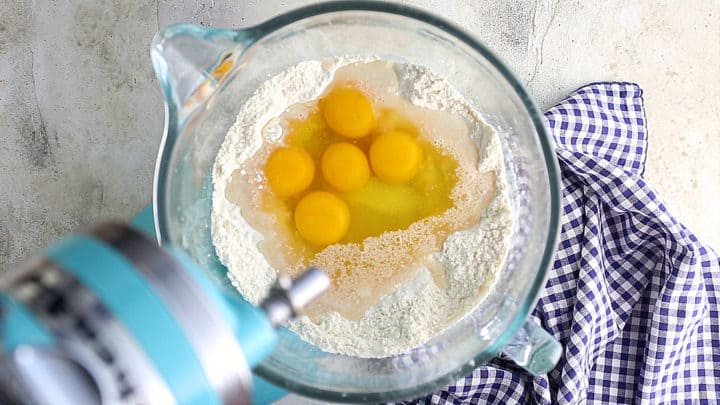
Mix everything together on low speed, using the dough hook attachment. This will probably take around 7 minutes, but you’ll have to stop halfway through to scrape the bottom and sides of the bowl with a silicone spatula.
Once you have everything incorporated, you should have a very loose (slack), sticky dough. Now it’s time to work in the butter.
Be sure to use soft butter, and drop it into the bowl one tablespoon at a time, allowing each addition to become fully incorporated before adding in the next one.
When all the butter has been added, the dough will still be very loose. Don’t worry! After a nice, long knead, it will tighten up quite a bit.
First, knead the dough on low speed for 10 minutes. Then turn the mixer up to medium, and let it go for another 15. Your mixer will really get a workout! But your brioche bread will have the most fantastic texture.
CHILL OVERNIGHT
Once the dough has gathered itself into a ball, remove it from the bowl, mist the bowl with non-stick spray, then put it back in. Cover it with greased plastic wrap and pop it into the fridge overnight.
SHAPE THE NANTAISE LOAF
The next morning, you will see that your brioche dough has grown quite a bit!
Turn it out onto a lightly floured surface, then divide it into 2 equal portions (this recipe makes 2 loaves).
Then divide each half into 8 equal portions.

Roll each portion into a smooth, tight ball, and line the balls up in 2 staggered rows of 4, in your greased loaf pans. To see how this is done, watch the video embedded in the recipe card below.
Here is a link to the loaf pan you see me using here: Le Creuset Stoneware Heritage Loaf Pan.
You don’t have to shape your loaf this way. If you want to keep it simple, just shape it into a log, similar to the way I did with this soft whole wheat bread.
SECOND RISE
Once your brioche loaf has been shaped, cover it lightly with greased plastic wrap, and allow it to rise in a warm place for 4 to 5 hours.
You want to be really careful with this second rise. If you don’t allow it enough time, it could come out gummy, with a dense texture. If you give it too long, it could collapse as it bakes.
Allow the unbaked bread to rise to double its original volume.
Another way to tell if it’s proofed just right is to find an inconspicuous place to press in your fingertip, just up to the first knuckle. If the indentation holds its form, the dough is done rising.
Brush it with egg wash (one egg beaten with a tablespoon or so of water) to give it a gorgeous, golden brown sheen.
BAKE
Bake this brioche bread until it’s puffy, golden brown on the top, and set in the middle, or to an internal temperature of 190 degrees F.
Then allow it to cool for about 30 minutes, before removing it from the pan.
DO YOU HAVE TO USE A STAND MIXER?
I do recommend using a stand mixer to make this recipe, just because it’s such a sticky dough and it requires so much time kneading. Here is a link to the kind of mixer I use: KitchenAid Artisan Stand Mixer.
If you tried to make it by hand I’m afraid it might be really difficult and frustrating.
I definitely would not suggest using an electric hand mixer, as it wouldn’t be powerful enough and you’d probably burn out the motor.
A bread machine would probably work well. Full disclosure: I haven’t tried it myself so I can’t say for sure, but it seems to me like it should work ok.
GLUTEN-FREE OR DAIRY-FREE BRIOCHE
Again, I have not tried this myself so I can’t vouch for the results, but if you wanted to try making a gluten-free brioche, look for a gluten-free flour blend that subs 1:1 for regular flour.
For dairy-free brioche, any butter substitute that swaps 1:1 for regular butter should work.
I’m not sure if I’d recommend trying a vegan brioche, but if you really feel like experimenting, you might try using flax or chia eggs. For each egg, mix 1 tablespoon of ground flax or chia seeds with 2 to 3 tablespoons of water. Allow this to sit for 15 minutes or so, until thickened/gelled.
BRIOCHE USES
This bread is so delicious you could just eat it plain. Seriously, it’s so buttery it really doesn’t need a thing. But if you really want to take it over the top, try spreading it with more butter and a generous smear of strawberry jam.
It also makes a fantastic sandwich bread. I love to make a grilled ham and cheese with it, with a little smudge of Dijon mustard. So good!
And if it starts to get a little stale, it’s perfect for French toast or bread pudding. Try it in this French Toast Casserole, or this Bread & Butter Pudding.
HOW TO STORE BRIOCHE
If you want to make them ahead, the unbaked loaves can be frozen in foil-lined pans, then removed and tightly wrapped. The dough will keep in the freezer for up to 2 weeks.
You can then thaw it and allow it its second rise, and continue on with the recipe instructions from there.
To store your brioche bread after it’s been baked, just keep it in an airtight container or zip-top bag. It will keep at room temperature for a few days, or in the fridge for around a week.
A FEW MORE OF MY FAVORITE BREAD RECIPES:
As an amazon associate I earn from qualifying purchases.

Brioche Bread
Ingredients
- 2 1/4 cups (281.25 g) all-purpose flour
- 2 1/4 cups (281.25 g) bread flour
- 1/2 cup (118.29 g) water
- 3 1/4 teaspoons (16.02 g) dry active yeast, (1 1/2 packets)
- 1/2 cup (100 g) granulated sugar
- 1 tablespoon (14.79 g) kosher salt
- 5 (220 g) eggs, , large
- 22 tablespoons (325.31 g) unsalted butter, (2 3/4 sticks), softened
- egg wash, (1 egg beaten with 1 tablespoon water)
Instructions
- Place the all-purpose and bread flours in a large mixing bowl and whisk to combine.
- Add the water, yeast, sugar, salt, and eggs, and mix together on medium-low speed until combined (approx. 7 minutes), stopping to scrape the bottom and sides of the bowl with a silicone spatula.
- While continuing to mix on low speed, add the butter a tablespoon at a time, allowing each addition to fully incorporate before adding the next.
- When all the butter has been added, knead the dough on low speed for 10 minutes, then increase the speed to medium and knead for an additional 15 minutes.
- Allow the dough to chill in a greased, covered bowl overnight in the refrigerator .
- Divide the dough in half, then divide each half into 8 equal portions.
- Roll each portion in a tight, smooth ball, and line the dough balls up in 2 staggered rows of 4, in each of 2 greased loaf pans (see video below).
- Cover the loaf pans with greased plastic wrap, then allow them to rise in a warm place for 4 to 5 hours.
- Preheat the oven to 350 degrees F and brush the unbaked loaves with egg wash.
- Bake the loaves until puffed, deeply golden, and set (approx. 30 to 40 minutes).
- Cool for 30 minutes in the pans, then transfer them to a wire rack to cool completely.

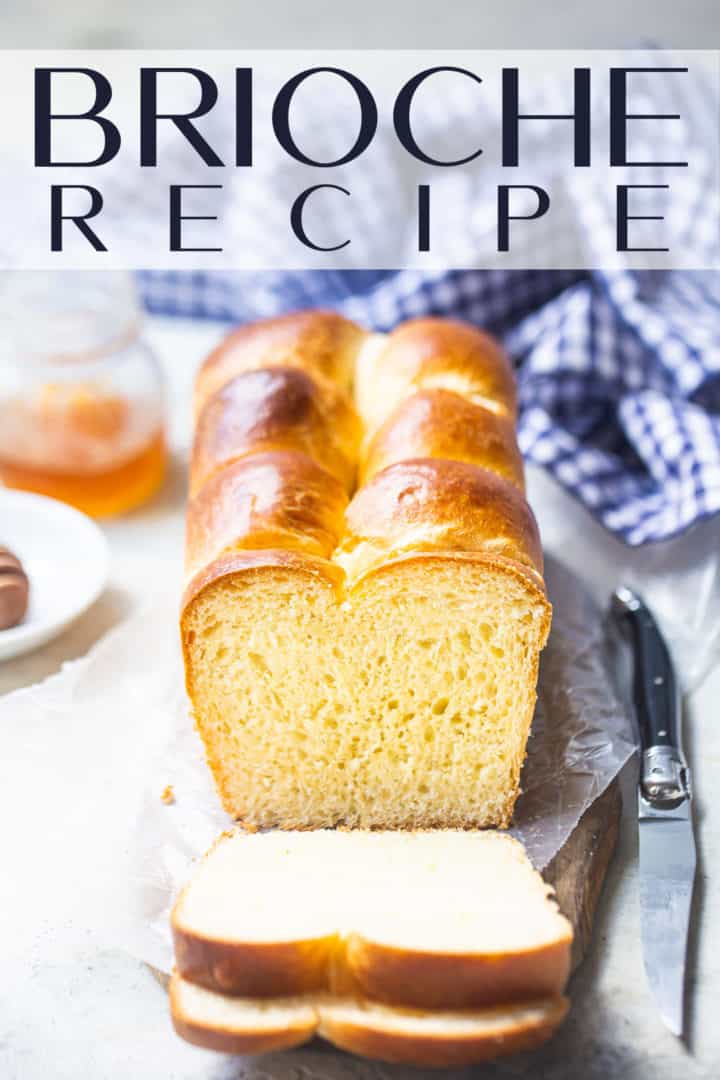


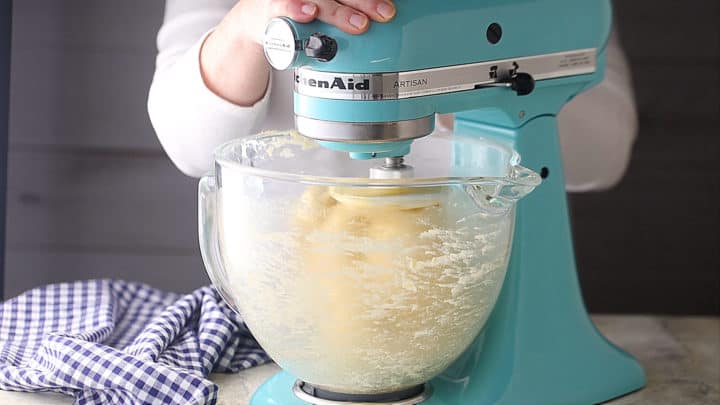

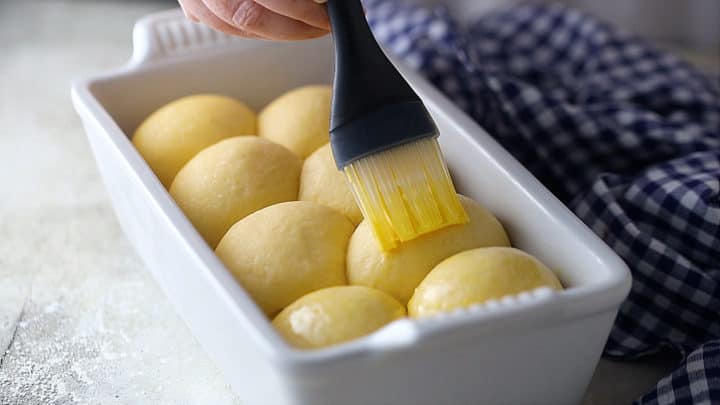
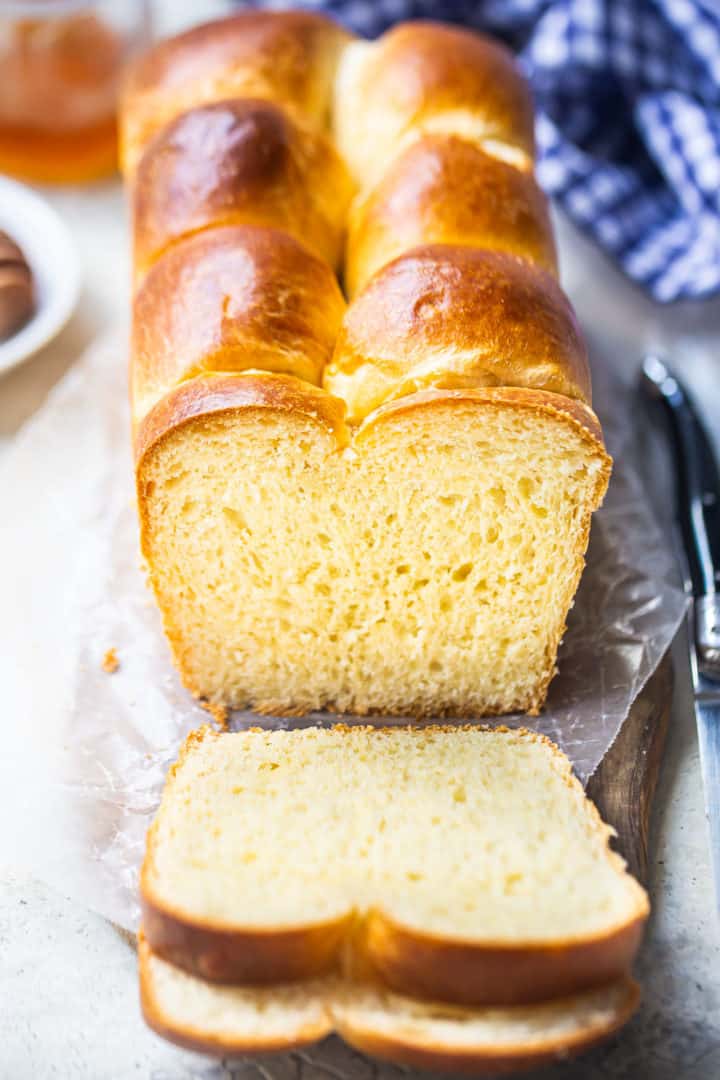
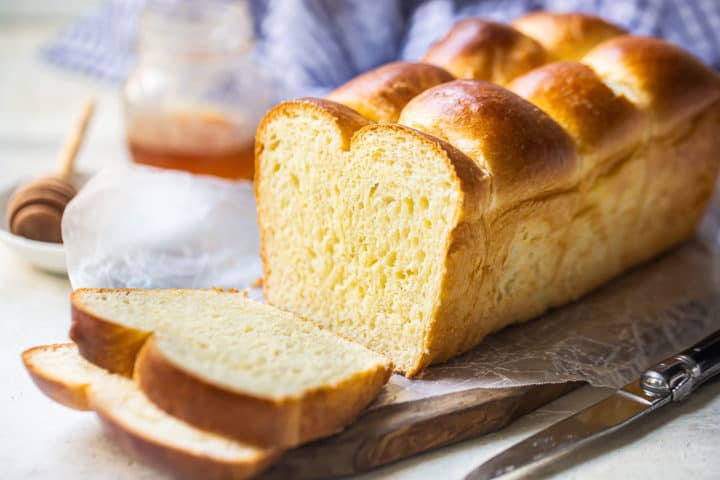














It was delicious, oh so soft… thanks for your detailed recipe. I got it completely right the very first time.
Loved the bread! Sweet & tasty! For some reason the bread came out very very crumbly but I’m working on that part!
I would have given all 5 stars but the long long dissertation before the recipe was just way to much! Any one that’s made any type of bread knows what to do with a recipe & all those details are more or less taking up room & time! Kinda a little self centered as well!
Nothing self-centered about it. I don’t think I even mentioned myself at all, other than to say that I like this type of bread. The “dissertation” as you put it is meant to help people understand the steps and how to get the best end result possible. If you had to sit for hours every week answering questions from readers and troubleshooting, perhaps you could understand that a little better.
I have been baking all kinds of bread for over 40 years but never tried Brioche. This recipe looked good so I tried it! What a horrible waist of 5 large eggs, & a lot of butter & flour! I use fresh yeast & followed the directions to the letter! Absolutely nothing happened, it did not rise even a little! A terrible waist, to say the least! I
I was leery about not using warm water with the yeast. I guess that should have been a huge red flag!
I’m going to be more careful about using on-line recipes! No matter who’s name are them!
This was an expensive mistake!
If you used fresh yeast, then you did not follow the directions to the letter. This recipe calls for dry active yeast. They are not the same thing.
Great recipe, easy to follow! The brioche were soft, fluffy and buttery. I tried several recipes and this will be my go to recipe! The brioche were huge! Thanks for sharing a wonderful recipe.
Trying tonight – and surprised that I don’t need to use warm water to “activate” the yeast? Is this because its an overnight dough? I’m nervous!
Yes it’s because it’s an overnight dough- you want to slow down the rise to allow the flavor to develop. Good luck!
Thank you for replying to my comment/question! I’m an experienced baker but am really just starting to dabble in bread making. I have tried brioche before (different recipe) with a poor brick-like result so I was extra nervous about this attempt. I am happy to tell you that I could not be more delighted with the result! This bread is beautiful, fluffy and DELICIOUS! So.SO.Yummy! Thank you for the great recipe and instruction! 🙂
5 Stars!
Its awfully delicious
Don’t knead (haha, a bread joke) to use bread flour. Just add a tablespoon of vital wheat gluten (“vwg”) to your regular flour (so use 4 1/2C (less 1T) ALL all-purpose flour and add a 1T of vwg to your mix. Same result.
Love those brioche buns you referenced so this is a winner too!
Awesome, great to know! Thanks for the tip!
Hi Allie, I made the Brioche Bread two days ago. OMG so good, followed your instruction. I made two adjustments, I used whole wheat white and 1 1/4 C all purpose flour, 1/4 C Vital wheat Gluten Flour. The results, was Better than I thought. The bread was moist and high in volume, soft, delicious. I had to freeze the other one, it does makes a super sandwich. I will try your other French Bread Brioche (less eggs & butter). This time I will get the correct loaf pan, might make a difference?
Thank you for sharing,
Georgia
So happy you were pleased! Thanks for letting us know about your ingredient subs too; I’m sure that will be very helpful to other readers.
Dear Sir,
I am emailing from Zambia with an interest to bakery equipments , ovens and starting full time bakery. This means more information and training, help me with any downloads. Will appreciate.
Regards.
Regards Greenford.
I’m sorry, but I don’t think I’m the right person to ask. I’ve worked in bakeries but I do not own one. I would not know how to advise you on this.
Wouldn’t the second knead at 15 minutes on medium speed (what number is considered medium?) burn out the mixer? The KitchenAid manual says not to knead bread beyond speed 2.
You can do it however you like but this is what worked for me. It did not burn out my mixer. Perhaps because this is such a soft dough?